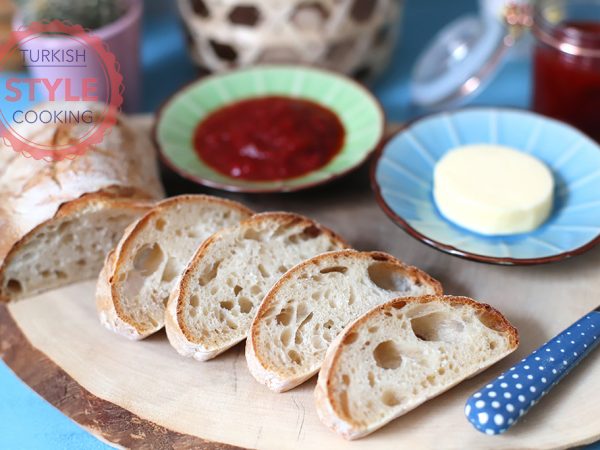Sourdough French Baguette

After the sourdough starter recipe I shared last week, it was necessary to share sourdough bread recipes also. If your sourdough starter is ready or about to be ready, this can be your first sourdough bread trial.
If you ever looked for a sourdough bread recipe and read articles about it you should have seen that there are thousands of ways of making sourdough bread. While reading the concerning articles I realized that if every way is correct, then it's impossible to fail sourdough bread unless you fail some basic things such as using inactive starter or hurrying to bake the bread.
There are just three tips of making sourdough bread. 1. Active sourdough starter. 2. Giving enough time to the dough. 3. Baking properly.
The cooking time varies considerably in every recipe, but much more in the sourdough bread. The size of bread, flour + water ratio, the size of the oven, the equipment you use to bake. Therefore, it is best to determine the heat and time that you need to use on your own terms according to your experience. Using the time and heat given in the recipes will give you someone or something to blame for your underbaked bread. But you don't need someone to blame and a raw bread, you just need a baked bread. In order to have what you need, you should listen to bread instead of keeping time. It talks to you constantly while baking. It just doesn't make it like people. Instead, it talks in size or color. Since there is no such departments as bread language and literature in the universities, there is only one source to learn this language; the bread itself. While baking bread, you start to understand it by keeping track of your experiences or by taking notes.
However, if you cannot be sure if it's baked or not, I will share a final control method. When you take the bread out of the oven, weigh it in your hands. If it is heavier than it seems it means that it's underbaked, if it's lighter, it means that it's beaked. As the bread is baked, the water inside evaporates, so the bread gets lighter. If the water is not evaporated enough the bread doesn't get lighter.
Enjoy the recipe...
Ingredients
- 150 g of active sour yeast,
- 200 g of standard white flour,
- 200 g of high protein white flour,
- 300 g of cold water,
- 1 teaspoon of salt.
Preparation
- Combine yeast, water and the flour in a deep bowl and knead until homogeneous,
- Cover with a plastic wrap and set aside for for 30 minutes,
- Sprinkle the salt over and knead on the counter for 5 min. (add flour if necessary),
- Cover with a plastic wrap and set aside for 1 hour,
- Taking from bottom and putting on top fold for 10-15 times, cover and set aside for 1 hour again,
- Fold two times more, cover and set aside in the fridge for 12-24 hours,
- Remove from the fridge, knead and cut into two pieces,
- Give baguette shape to each piece and place on a kitchen cloth sprinnkled with flour,
- Fold the cloth from both sides to prevent spreading, let rest for 2 hours,
- Heat oven to 220 C degrees with the baking stone or baking sheet inside,
- Place another baking dish in the bottom,
- Place the baguettes on the stone or baking sheet, scratch the top with a bread razor,
- Pour 2-3 cups of water into the dish in the bottom,
- Bake until the breads are beautifully browned.
Bon appetit...